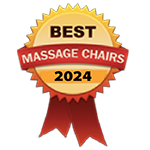Troubleshooting Massage Chair Electrical Components
The most common problem is the chair is not connected to the electrical supply or the electrical supply is not working. This could be due to a tripped breaker or blown fuse in the home, or the outlet the chair is plugged into is controlled by a switch on the wall.
Solution: Make sure there is electrical current (try plugging a lamp into the outlet the chair is plugged into), and that the cord from the transformer is connected to the outlet. If the chair is adequately supplied with power and the motor is still non-functional, the problem may be in the hand control, transformer, or motor.
Solution: Replace the hand control. Since the hand control is used on a daily basis, food or liquid will affect its performance. If you have access to a multimeter, you can do a few simple safe tests to determine what the problem may be.
Test to perform with a multimeter:
1) Check the Transformer / Motor Power Lead
- Turn chair on its side and find the leads coming from the motor housing.
- At the motor, disconnect the small cord with a two-prong end coming from the transformer.
- Plug the chair into the wall, (the Okin motor is a safe 24 low volt system).
- Set your multimeter to the DC VOLTS setting put your RED lead into the SMALLER of the two openings on the cord then your BLACK meter lead into the LARGER opening. If your meter reads from 18-22 volts, then the transformer and transformer lead to the motor are good.
- If there is no current reading, then unplug the wire lead coming out of the transformer, and do the same check described above at the transformer. If there is a voltage reading, then the lead from the transformer to the motor is bad. If no voltage reading, then the transformer needs to be replaced.
2) Check Hand Control
- Unplug the chair from the power source.
- Disconnect the hand control (quick disconnect) from the motor connector.
- Set your multimeter to the OHMS setting.
- Place the RED multimeter lead on PIN 1 of the hand control cord.
- Place the BLACK lead on PIN 2.
- Press and hold the "recline" switch. A read of zero (0) ohms means the "recline" function of the hand control is operating properly.
- Move the BLACK lead to PIN 3.
- Press and hold the "lift" switch. A reading of zero (0) ohms means the "lift" function of the hand control is operating properly.
- If either test fails, the hand control needs to be replaced.
3) Check the Motor
- Unplug the chair from the power source.
- At the motor, disconnect the small two prong cord coming from the transformer.
- Set your millimeters to the OHMS setting.
- Place one lead on each pin coming from the motor.
- If less than one (1) ohm is read on the meter, replace the motor.
Motor runs, but chair will not move, or only partially moves, or makes squeaking or creaking noise.
PROBLEM: Metal lift frame, scissor mechanism, T-bar disconnected, fork end on lift tube.
CAUSE: The most frequent cause of the above problems is insufficient space between the chair and a wall, where the chair was reclined into the wall causing undue stress on the lift mechanism.
SOLUTION: Turn the chair on its side. Examine the entire base of the chair for bends and breaks. Check the scissor mechanisms for excessive wear or broken welds and or rivets. Examine the wood and the lift frame near the scissors for cracks, or breaks. Check the end of the motor lift tube, where it bolts to the chair; on older chairs it is made of a composite plastic. Newer chairs, it is a diecast part, and is called the fork end of the motor assembly.
Battery backup system not working
PROBLEM: Batteries may be dead or battery leads may be damaged.

